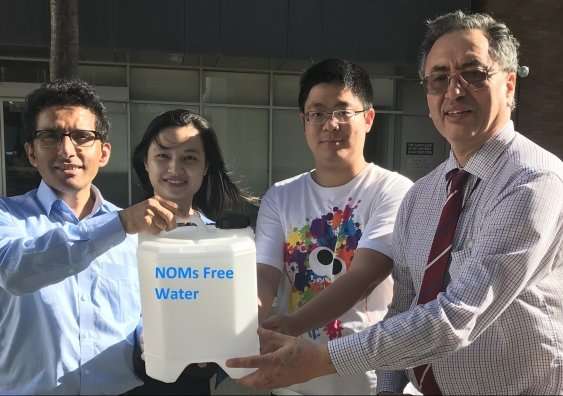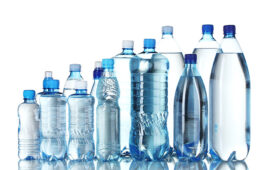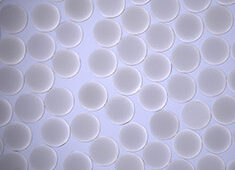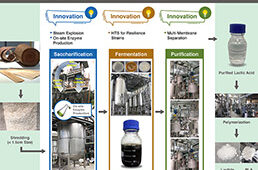
UNSW’s Dr Rakesh Joshi (far left) and team members hand over water free of natural organic matter to Sydney Water’s Dr Heriberto Bustamante (far right). Credit: University of New South Wales
Even within a treatment plant, removing all natural organic matter (NOM) from drinking water is no easy task.
To tackle this challenge, a team from the University of New South Wales (UNSW) has created a graphene-based filter. The new treatment system is made by converting naturally occurring graphite into graphene oxide membranes. The graphene oxide membranes allow high water flow at atmospheric pressure, while removing virtually all of the organic matter.
This system can remove more than 99 percent of the NOM in treated drinking water. The researchers, in collaboration with Sydney Water, have demonstrated the success of the new approach in lab tests on filtered water from the Nepean Water Filtration Plant in western Sydney
They are now working to scale up the technology for possible use in conventional water treatment plants.
“Our advance is to use filters based on graphene–an extremely thin form of carbon,” Rakesh Joshi, PhD, of the UNSW School of Materials Science and Engineering, said in a statement. “No other filtration method has come close to removing 99 percent of natural organic matter from water at low pressure. Our results indicate that graphene-based membranes could be converted into an alternative new option that could in the future be retrofitted in conventional water treatment plants.”
According to the study, the laboratory scale use of graphene oxide membranes was for the removal of NOM from water that had been treated and still contained 5 mg/L of dissolved organic carbon.
“Our study shows that graphene oxide based membranes can reject ∼100% of NOM while maintaining high water flux of 65 L m−2 h−1 bar−1 at atmospheric pressure,” the study states. “Our results indicate that it is possible to develop a graphene oxide-based water filtration technology.”
NOM contaminants affect the performance of direct filtration plants by reducing their capacity after a heavy rain. It can also lead to increased disinfection byproducts.
“The most common methods used at present to remove organic matter from water supplies include the application of chemical coagulants,” Heriberto Bustamante, PhD, of Sydney Water, said in a statement. “However, these existing treatments are only partly effective, particularly as the concentration of natural organic matter is increasing.”
The Sydney Water supplies clean water to approximately 4.8 million people in Sydney, the Illawarra and the Blue Mountains. The UNSW team is upgrading the experimental rig to construct a small pilot plant that could be tested in the field.
The study was published in Carbon.
Y. You et al. Application of graphene oxide membranes for removal of natural organic matter from water, Carbon (2017). DOI: 10.1016/j.carbon.2017.12.032




